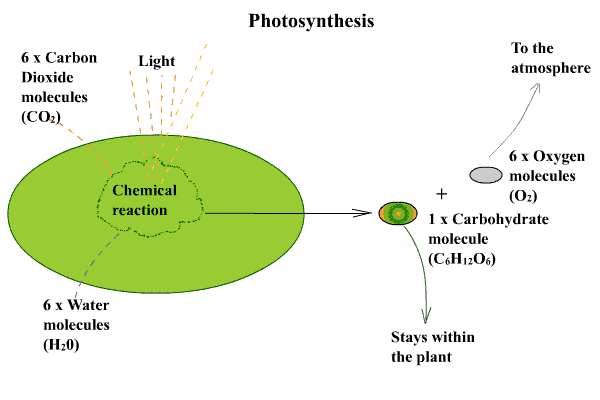What is Photosynthesis?
To enable green plants to grow adequately they need to produce their own organic food materials in the form of carbohydrates.
Green plants capture (or trap) light within green pigments that are contained within their leaves and stems.
These green pigments are called chlorophylls and they are present in small membranous structures (or organelles) called chloroplasts. A chloroplast is generally lens shaped and about 5µ x 2.3µ in size, i.e. 0.005mm x 0.0023mm .
Plants use the light to synthesise (or build up) compounds from carbon dioxide (CO2) and water (H2O) to form a larger compound - carbohydrate.
The chemical formula for this reaction can be written as follows:
6 CO2 + 6 H2O + Light --------> C6H12O6 + 6 O2
What this means is that 6 molecules of carbon dioxide (which is obtained from the air) plus 6 molecules of water (which are obtained from water within the plant) are combined through the energy from light to form a larger molecule, a carbohydrate C6H12O6, with there also being 6 molecules of oxygen being released back into the atmosphere as a result of the reaction. Both sides of the equation contain the same amount of molecules to ensure that it is properly balanced.

Carbon fixation is the term used for the incorporation of CO2 into organic compounds (carbohydrates).
The carbon dioxide enters the plant through its air cavities, or stomata, whilst water will enter initially through the roots and will be transported (translocated) up into the stem and leaves through the process of transpiration.
Photosynthesis occurs in daylight, not night-time.
The carbohydrates that are formed can be:
- Transported to storage organs, such as roots, stolons, rhizomes.
- Built into larger carbohydrates; or
- Reused as energy for growth (through the process of respiration).
Environmental Effects on Photosynthesis
Cool season grasses are most efficient at producing carbohydrates when:
- temperatures are in the range 16°C - 24°C,
- optimum temperatures for root growth, however, are 10°C - 18°C;
- water supply is plentiful;
- stomata are open;
- wind is not strong;
- light intensity is not too high or too low;
- light quality is of the appropriate wavelengths, i.e. blue and red;
- shade is not present;
- photosynthesis rates double between 10°C and 20°C;
- nutrients are adequately available, in particular potassium which is involved in controlling the opening and closing of stomata;
- shaving turfgrasses reduces the leaf area for photosynthesis;
- aim to have a height of cut as high as practicable, especially during early to late autumn to allow a build up of carbohydrate reserves in roots etc.
Photosynthesis rates decline above 25°C for cool season grasses.
